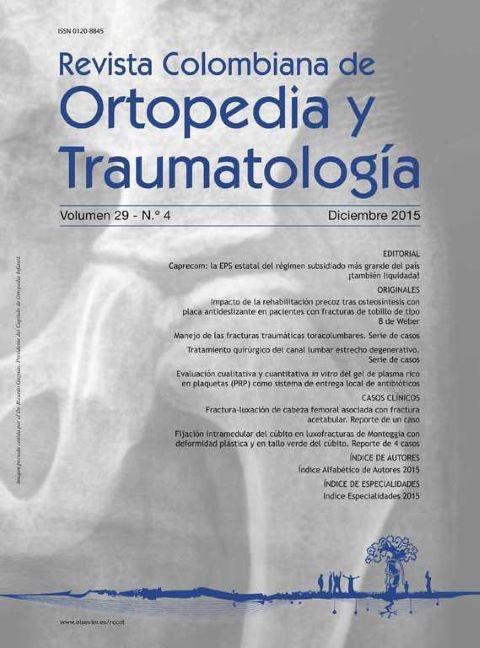Manejo de las fracturas traumáticas toracolumbares. Serie de casos
DOI:
https://doi.org/10.1016/j.rccot.2016.02.010Palabras clave:
fractura toracolumbar, fractura de tipo Burst, instrumentación corta sin fusiónResumen
Introducción: Las fracturas de la columna dorsolumbar se presentan entre las lesiones más graves del esqueleto humano, especialmente en los pacientes más jóvenes. A menudo son resultado de traumatismos de alta energía, como accidentes de tránsito o caídas desde gran altura. El objetivo del trabajo es revisar nuestro manejo de las fracturas toracolumbares traumáticas en pacientes jóvenes.
Materiales y métodos: Se realizó una serie de casos, que incluía la revisión de historias clínicas de 28 pacientes atendidos desde 2008 hasta 2013, clasificados según Magerl-AO, Load-Sharing, TLICS, tratamiento conservador y quirúrgico, seguimiento radiológico y funcional según la escala del cuestionario SF-36.
Resultados: Completaron los criterios de inclusión 12 hombres y 16 mujeres con un seguimiento promedio de 3,1 años y una media de edad de 36,8 años. Según Magerl-AO: 6 tipos A1, 12 tipos A3, 2 tipos A4, 4 tipos B2 y 4 tipos C2. Según Load-Sharing: 9 con puntuación mayor a 6. Según TLICS: 6 con puntuación menor a 4 y 10 con puntuación mayor a 5. Radiográficamente: cifosis prequirúrgica de 12,3º y 16,7º, y en el último control, de 9,7º y 5º para los tratamientos conservador y quirúrgico, respectivamente. El acuñamiento prequirúrgico promedio fue el 30,9% y en el último control, del 6,6 y el 6% para los tratamientos conservador y quirúrgico, respectivamente. El tratamiento conservador se llevó a cabo en 6 pacientes y el quirúrgico, en 22 pacientes: 5 con fijación corta sin fusión y 17 con fijación larga con fusión. De acuerdo con el SF-36, el promedio fue 73 puntos para las de manejo conservador y 60,1 para el tratamiento quirúrgico.
Discusión: En fracturas de tipo Burst, según Load-Sharing, el tratamiento quirúrgico con instrumentación corta sin fusión es un método efectivo para lograr la estabilidad y alineación sagital deseada y preservar la función de los segmentos. En fracturas inestables, si bien la instrumentación posterior larga ofrece buenos resultados, sacrifica la función de segmentos adyacentes que podrían conservarse con instrumentación combinada anterior y posterior.
Nivel de evidencia clínica: Nivel IV.
Descargas
Referencias bibliográficas
Briem D, Behechtnejad A, Ouchmaev A, Morfeld M, Schermelleh-Engel K, Amling M, et al. Pain regulation and health-related quality of life after thoracolumbar fractures of the spine. Eur Spine J. 2007;16:1925-33. https://doi.org/10.1007/s00586-007-0395-x
Öner F, Wood KB, Smith JS, Shaffrey CI. Therapeutic decision making in thoracolumbar spine trauma. Spine. 2010;35 21 Suppl:S235-44. https://doi.org/10.1097/BRS.0b013e3181f32734
Magerl F, Aebi M, Gertzbein SD, Harms J, Nazarian S. A comprehensive classification of thoracic and lumbar injuries. Eur Spine J. 1994;3:184-201. https://doi.org/10.1007/BF02221591
McCormack T, Karaikovic E, Gaines RW. The load sharing classification of spine fractures. Spine. 1994;19:1741-4. https://doi.org/10.1097/00007632-199408000-00014
Vaccaro AR, Lehman RA Jr, Hurlbert RJ, Anderson PA, Harris M, Hedlund R, et al. A new classification of thoracolumbar injuries: the importance of injury morphology, the integrity of the posterior ligamentous complex, and neurologic status. Spine. 2005;30:2325-33. https://doi.org/10.1097/01.brs.0000182986.43345.cb
Pizones J, Izquierdo E, Alvarez P, Sánchez-Mariscal F, Zúñiga L, Chimeno P, et al. Impact of magnetic resonance imaging on decision making for thoracolumbar traumatic fracture diagnosis and treatment. Eur Spine J. 2011;20 Suppl 3:390-6. https://doi.org/10.1007/s00586-011-1913-4
Van der Roer N, de Lange ES, Bakker FC, de Vet HC, van Tulder MW. Management of traumatic thoracolumbar fractures: a systematic review of the literature. Eur Spine J. 2005;14: 527-34. https://doi.org/10.1007/s00586-004-0847-5
White AA, Panjabi MM. Clinical biomechanics of the spine. 2.a edición Philadelphia: Lippincot Williams and Wilkins; 1990.
Dickman CA, Yahiro MA, Lu HT, Melkerson MN. Surgical treatment alternatives for fixation of unstable fractures of the thoracic and lumbar spine: a meta-analysis. Spine. 1994;19 Suppl 20:2266-73. https://doi.org/10.1097/00007632-199410151-00003
Fletcher DJ, Taddonio RF, Byrne DW, Wexler LM, Cayten CG, Nealon SM, et al. Incidence of acute care complications in vertebral column fracture patients with and without spinal cord injury. Spine. 1995;20:1136-46. https://doi.org/10.1097/00007632-199505150-00005
Clohisy JC, Akbarnia BA, Bucholz RD, Burkus JK, Backer RJ. Neurologic recovery associated with anterior decompression of spine fractures at the thoracolumbar junction (T12-L1). Spine. 1992;17 Suppl 8:325-30. https://doi.org/10.1097/00007632-199208001-00019
Osebold WR, Weinstein SL, Sprague BL. Thoracolumbar spine fractures: results of treatment. Spine. 1981;6:13-34. https://doi.org/10.1097/00007632-198101000-00004
Aebi M, Etter C, Kehl T, Thalgott J. The internal skeletal fixation system: a new treatment of thoracolumbar fractures and other spinal disorders. Clin Orthop. 1988;227:30-43. https://doi.org/10.1097/00003086-198802000-00006
Broom MJ, Jacobs RR. Current status of internal fixation of thoracolumbar fractures. Journal Orthop Trauma. 1989;3:148-55. https://doi.org/10.1097/00005131-198906000-00010
Jacobs RR, Asher MA, Snider RK. Thoracolumbar spinal injuries: a comparative study of recumbent and operative treatment in 100 patients. Spine. 1980;5:463-77. https://doi.org/10.1097/00007632-198009000-00012
McLain RF. The biomechanics of long versus short fixation for thoracolumbar spine fractures. Spine. 2006;31 11 Suppl:S70-9, discussion S104. https://doi.org/10.1097/01.brs.0000218221.47230.dd
Resch H, Rabl M, Klampfer H, Ritter E, Povacz P. Surgical vs. conservative treatment of fractures of the thoracolumbar transition. Unfallchirurg. 2000;103:281-8. https://doi.org/10.1007/s001130050537
Kim YM, Kim DS, Choi ES, Shon HC, Park KJ, Cho BK, et al. Nonfusion method in thoracolumbar and lumbar spinal fractures. Spine. 2001;36:170-6. https://doi.org/10.1097/BRS.0b013e3181cd59d1
Yugué I, Aono K, Shiba K, Ueta T, Maeda T, Mori E, et al. Analysis of the risk factors for severity of neurologic status in 216 patients with thoracolumbar and lumbar burst fractures. Spine. 2011;36:1563-9. https://doi.org/10.1097/BRS.0b013e3181f58d56
Descargas
Publicado
Cómo citar
Número
Sección
Licencia
Derechos de autor 2024 Revista Colombiana de ortopedia y traumatología

Esta obra está bajo una licencia Creative Commons Reconocimiento 3.0 Unported.








